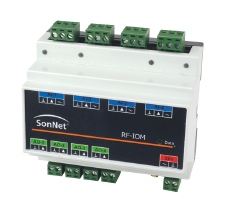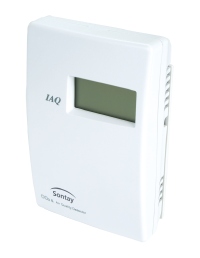Sensible thinking

Without room sensors, a building-management system cannot operate — and the better the sensors the better the system can perform. Alan Braybrook of Sontay examines the role that room sensors have played in the rise of building control systems and discusses what makes for a good sensor.
At Sontay, we are celebrating 40 years in business. Since the company’s inception in 1974 the building-controls industry has changed radically. Building-management systems (BMSs) are now an integral part of commercial buildings and play a pivotal role in monitoring and saving energy. These systems are highly sophisticated, but for all their brilliance their success is still dependent on the humble sensor.
Products for sensing and transmitting room temperature and relative humidity began with the development and proliferation of centralised building-management systems in the 1980s. Right from their original introduction as the eyes and ears of the BMS, misconceptions have persisted in terms of how accurate these devices really need to be, how fast they should react and what precisely constitutes a high-quality room and/or duct sensor. These factors are important, and they demand closer consideration from consultants, contractors and systems integrators charged with delivering energy-efficient control systems for today’s buildings.
Measurement accuracy versus stability is often a talking point. Generally speaking, the industry has relied and continues to rely on temperature sensors which are low cost and tolerate ± 0.3 K over the entire range (-10 to +70°C). As a result, this specification has become the standard in the UK market.
However, what is really important from a sensing perspective is longer-term stability rather than absolute accuracy. It is much more important for devices to remain accurate within the manufacturer’s specification (± 0.3 K) for the life of the device than their absolute accuracy. After all, these devices are being applied within commercial buildings to enhance occupant comfort and improve energy savings over the long term. If our balance of priorities shifts in favour of performance stability over absolute accuracy then these benefits can be successfully realised.
 |
| Wireless technology is affecting perceptions of project cost. |
Sensor cost also remains an issue. Accounting for just 2% of the budget for a whole project, room sensors themselves are not always the main focus of attention when it comes to selecting and specifying the building-control system. However, different price-points often reflect a differential in quality. Choosing the lowest-cost sensor brings with it the increased risk of compromising on long-term measurement reliability and performance stability. Device failure can lead to the time and cost of unnecessary call out and product replacement issues, alongside the unwanted cost of reputational damage to the specifying contractor and consultant.
Increasingly popular wireless sensor technology is also having a fundamental impact in transforming how we think about the cost of sensor installation. By eliminating the need for structural cabling during sensor installation, wireless devices can greatly reduce engineering time and installed project cost. This enables faster and easier installation on new buildings and also opens up the opportunity for control specialists to retrofit energy-efficient HVAC controls into existing commercial and public buildings. In projects using our SonNet family of wireless sensors, we are typically finding total installed cost savings of 30% and more over comparable wired sensor installations. At a time, when reducing costs is a priority on many projects, proven wireless technology can bring significant benefits.
Seamless integration of wireless technology is essential, and making sensors compatible with current building-control systems aids this process. For example, our recently introduced RF-IOM-4A-4U input/output module works with SonNet sensors and routers and acts as a local I/O with connectivity to typical HVAC equipment, such as fan-coil units or variable-air-volume (VAV) boxes. The module can take any 0 to 10 V DC, 4 to 20 mA, resistive or VFC signal from wired devices in the field and transmit them to a SonNet RF-RXS receiver. This in turn can be read by a JACE controller through a Niagara framework. The strategy within the controller uses this information to calculate control values, which are then passed back through the I/O module to alter damper positions and other output connections in the field.
 |
| Multi-functional sensors for temperature, humidity and relative humidity are growing in popularity. |
Today, changing aesthetics and increased functionality are also important drivers in helping us re-evaluate the way that we look at sensors. Up until now, sensors in the space have been selected with little or no regard to design aesthetics. The latest devices offer an opportunity for specifiers not simply to satisfy the functional demands of their client but also the impact of the sensor on the interior space, and the look and feel of these devices.
At the same time, the longer-term trend is away from single-use sensors, such as one for temperature and one for humidity, to single, multi-functional environmental sensors. These modern devices can measure different important variables within the overall space conditions — which may include air quality and CO2 for occupancy, alongside traditional temperature and humidity measurements.
Today’s sensing devices can provide a better picture of the true building conditions over a long term in smaller packages that are more pleasing to the eye. The result is the creation of a broader market opportunity for control-systems specifiers and installers and, ultimately, the potential for more energy efficient buildings and reduced carbon emissions for all.
Alan Braybrook is sales and marketing director with Sontay.







